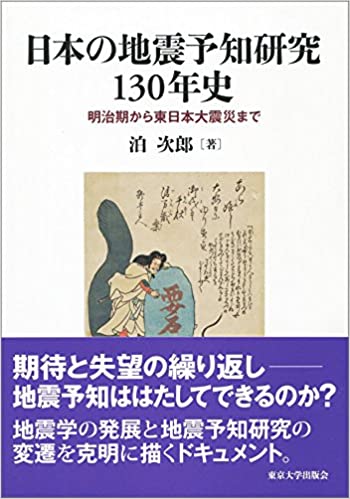 eEQP:eEQP-News-2023 Page eEQP:eEQP-News-2023 Page |
 
|
Earthquake Prediction Research and Disaster Mitigation
eEQP-News-2023 Page |
Editor: Toru Nakagawa (Emeritus Professor, Osaka Gakuin University)
|
Posted (in Japanese): Jun 6, 2023; Latest update: Feb. 18, 2024
Posted (in English): Feb. 18, 2024
|
Posted (in English): Feb. 18, 2024 |
For going to Japanese pages, press  buttons.
buttons.
Editor's Note (Toru Nakagawa, Feb. 15, 2024)
This is the English page of 'Earthquake Prediction Research and Disaster Mitigation : eEQP-News-2023 Page', corresponding to its Japanese page  , but translated in a simpler manner.
, but translated in a simpler manner.
Top of this page |
EQP First Parent page
East Japan EQ (2011)   |
EQP Second Parent page
Introduction to EQP research (2015)   |
EQP Third Parent page
EQ Prediction: Research & Mitigation
(2023)   |
Nakagawa Presentation (EPSJ 2023)   |
|
|
Japanese page |
Posted in 2023
 On the Direction of Development of Earthquake Prediction Research (Toru Nakagawa, EPSJ Annual Conference, Dec. 22, 2023)
On the Direction of Development of Earthquake Prediction Research (Toru Nakagawa, EPSJ Annual Conference, Dec. 22, 2023) (Dec. 25, 2023)
(Dec. 25, 2023)
EPSJ Anual Conference 2023, held on Dec. 22-23, 2023, at Univ. of Electro-Communication (Tokyo) and Online.
The Nakagawa's entire presentation materials in Japanese are posted.
Presentation paper (HTML  ; PDF
; PDF  (Conference Proceedings) (6 pages) );
(Conference Proceedings) (6 pages) );
Presentation slides (HTML  ; PDF
; PDF  ; PDF
; PDF  (4 slides/page) );
(4 slides/page) );
Presentation video (Recorded rehearsal on the previous day, MP4  (15 min 56 sec, 48.5 MB).
(15 min 56 sec, 48.5 MB).
Even though I am not a specialist in EQ (prediction) research, I presented my thought as a researcher on the importance of EQ prediction research and how it can be advanced. My Abstract is:
Based on the theory of plate tectonics, recent seismology has enabled long-/medium-term probabilistic forecasting of earthquakes (EQs), using the analysis of seismic motion with networks of seismographs and the analysis of crustal motion measured by geodetic satellites. But it avoids the research of short-term/imminent prediction of EQs, assuming that such prediction is currently impossible. However, most of the public wants to make the short-term/imminent EQ prediction possible to reduce the EQ disaster; and this desire is exactly the goal of the Earthquake Prediction Society of Japan (EPSJ).
The present paper discusses the methodology for realizing the goal. Our basic strategy is to capture the precursor phenomena. We take the approach of experimental science, relying on observations and experiments rather than theories, and we also focus on electromagnetic phenomena rather than mechanical phenomena. In particular, the present paper notes the observation of signals in the underground electric field by Minoru Tsutsui (2022) and therefore proposes to start a research project to verify the signals as EQ precursors by simultaneous observation at multiple sites and to establish a method for short-term/imminent prediction of EQs.
 Introducing the website of Earthquake Prediction Society of Japan (EPSJ) (Toru Nakagawa) (Dec. 10, 2023 - )
Introducing the website of Earthquake Prediction Society of Japan (EPSJ) (Toru Nakagawa) (Dec. 10, 2023 - ) 
EPSJ Homepage: https://www.eqpsj.jp/index.html  (in Japanese).
(in Japanese).
Links to its main pages are shown;
major activities and articles will be briefly introduced.
EPSJ Annual Conference 2023: December 22-23, 2023, Univ. of Electro-Communications & online (2023.12.11)
 jEQP: Earthquake Prediction Research and Disaster Mitigation (jEQP-Index Page) (Toru Nakagawa)
jEQP: Earthquake Prediction Research and Disaster Mitigation (jEQP-Index Page) (Toru Nakagawa)  (Dec. 12, 2023)
(Dec. 12, 2023)
Reconfirming the importance of the issue "Earthquake Prediction Research and Disaster Mitigation", I have decided to set this theme as one of the important pillars of this website "TRIZ Home Page in Japan". Accordingly, I have made the new folder jEQP directly under the website home, and have moved the TRIZ Forum: On Earthquake Prediction Research and Disaster Mitigation (3rd Index Page) to the new folder as its main index page. Main contents at present are:
(I)
On The East Japan Earthquake, Tsunami, and Nuclear Power Plants 


 (Mar. 23, 2011, May 19, 2011)
(Mar. 23, 2011, May 19, 2011)
(II) Introduction to the Research of Short-term (or Just-before) Prediction of Earthquakes by Use of Electromagnetic Phenomena: 
 (Mar. 9, 2015)
(Mar. 9, 2015)
(III) TRIZ Forum: On Earthquake Prediction Research and Disaster Mitigation (3rd Index Page) (Toru Nakagawa) 
 (Jun. 6, 2023)
(Jun. 6, 2023)
==> Now reformed into the present page: 'Earthquake Prediction Research and Disaster Mitigation (eEQP-Index Page)  (Dec. 12, 2023)
(Dec. 12, 2023)  (Feb. 18, 2024)
(Feb. 18, 2024)
 TRIZ Forum: On Earthquake Prediction Research and Disaster Mitigation (3rd Index Page) (Toru Nakagawa)
TRIZ Forum: On Earthquake Prediction Research and Disaster Mitigation (3rd Index Page) (Toru Nakagawa)  (Jun. 6, 2023)
(Jun. 6, 2023)
"Earthquake prediction research" is an exceptional topic for this "TRIZ Home Page in Japan". In 2011, right after the Great East Japan Earthquake (earthquake, tsunami and nuclear power plant accident), I sent e-mail messages to our readers around the world and received sympathetic and encouraging messages from more than 100 people from over 30 countries 
 . Since then, the issues of earthquake prediction and disaster mitigation have become increasingly serious in Japan. In 2015, I joined the Earthquake Prediction Society of Japan and started a Forum page on my website to showcase earthquake prediction research
. Since then, the issues of earthquake prediction and disaster mitigation have become increasingly serious in Japan. In 2015, I joined the Earthquake Prediction Society of Japan and started a Forum page on my website to showcase earthquake prediction research 
 . However, the forum has not been active for these 8 years because it was difficult for me as a non-professional to decide what and how to introduce. The issues are now much more demanding in Japan due to the high risk of large earthquakes in the near future. Therefore, I am now starting the Forum on Earthquake Prediction Research
. However, the forum has not been active for these 8 years because it was difficult for me as a non-professional to decide what and how to introduce. The issues are now much more demanding in Japan due to the high risk of large earthquakes in the near future. Therefore, I am now starting the Forum on Earthquake Prediction Research  , for the 3rd time.
, for the 3rd time.
Today, I am posting my reviews of two excellent books on earthquake prediction research in Japan.
(1) "Earthquake Prediction: Development and Prospects" by Tsuneharu Rikitake (Japan Professional Books Publishing, Jan. 2001, 617 pages), review by Toru Nakagawa (Apr. 20, 2015, posted on Amazon website)  (in this website, Jun. 6, 2023)
(in this website, Jun. 6, 2023)  .
. 
A complete compilation of earthquake prediction research up to the year 2000. An excellent book, professional yet easy to read for everyone.
(2) "130 Years of Earthquake Prediction Research in Japan: From the Meiji Era to the Great East Japan Earthquake" by Jiro Tomari (University of Tokyo Press, May 2015, 686 pages), review by Toru Nakagawa (Jun. 2, 2023, posted on Amazon website)  (in "TRIZ Home Page in Japan", Jun. 6, 2023)
(in "TRIZ Home Page in Japan", Jun. 6, 2023)  .
.
 Book Review: Jiro Tomari, "130 Years of Earthquake Prediction Research in Japan: From the Meiji Era to the Great East Japan Earthquake", (University of Tokyo Press, May 2015, 686 pages), review by Toru Nakagawa (Jun. 2, 2023, posted on Amazon website)
Book Review: Jiro Tomari, "130 Years of Earthquake Prediction Research in Japan: From the Meiji Era to the Great East Japan Earthquake", (University of Tokyo Press, May 2015, 686 pages), review by Toru Nakagawa (Jun. 2, 2023, posted on Amazon website) 
 .
.
|
An excellent work for earthquake researchers, disaster prevention and government officials, and all citizens who want to mitigate earthquake disasters.
This book was published 8 years ago, but I did not know about it and just read it for the first time. I am very impressed with the book and I regret that I have not widely surveyed good references. It is an excellent reference that contains a wealth of technical and social information that is much to learn. The book is so rich and dense that we cannot make a short summary. Here I will write what I learned and thought from the book: |
|
 |
The goals of earthquake research are prediction and mitigation, which form two wheels of a cart.
There are three approaches to earthquake prediction:
Prediction based on data from a large number of past seismic events (which has contributed to long/medium-term prediction); prediction based on some precursor phenomena; and prediction based on physical models.
For short/immediate term prediction, the use of "precursor phenomena" is most expected. But a number of objective criteria must be met to be accepted as "precursor phenomena", and none have yet been accepted as true "precursor phenomena". Even a foreshock earthquake cannot be called a "precursor" because it cannot predict whether or not a larger earthquake will soon follow.
Because of the diversity of earthquakes, we should not assume that there is a universal "precursor phenomenon" (applicable to any earthquake).
We must refer to the numerous previous studies and not be too optimistic (to meet the public's expectations).
However, we should still pursue the realization of "earthquake prediction" (as a science and for practical purposes).
Moving away from the conventional mechanical perspective (ground movement, pressure, strain, tremors, etc.), we should look for some electromagnetic precursor phenomena. This is an extremely difficult task that I believe we should pursue.
Top of this page |
EQP First Parent page
East Japan EQ (2011)   |
EQP Second Parent page
Introduction to EQP research (2015)   |
EQP Third Parent page
EQ Prediction: Research & Mitigation
(2023)   |
Nakagawa Presentation (EPSJ 2023)   |
|
|
Japanese page |
Last updated on Feb. 18, 2024. Access point: Editor: nakagawa@ogu.ac.jp
